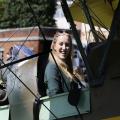THIS week’s Bygones focuses on some unique photos from the Chronicle archive when our (less congested) streets whirred and clanked to the sound of trams.
In 1901, The Reading Corporation Tramways, acquired the (very similarly named) Reading Tramway Company, who mainly operated horse drawn passengers services around the borough.
The new company started modernising the whole system in July 1903, with a ‘spaghetti junction style’ network of rails converging on the St May’s Butts and Broad Street crossroads.
In between the tracks was then filled in with cobblestones, occasionally some of this old road surface is seen when roadworks expose them temporarily.
Later in that same year, the first services began ferrying the public to and from the Cemetery Junction area to the east of Reading.
Soon the widening routes included Whitley, Bath Road (west) and Caversham (although not over the bridge).
Over thirty four-wheeled double decker cars saw early service and there was even a special ‘water car’ designed to lessen the dust brought up on their travels, by dampening down the trackside areas.
With the onset of the First World War, the plans to extend a trackway into Caversham had to be shelved, and after the cessation of hostilities no enthusiasm was left for this particular venture.
By 1919, the first motor buses used the road and tracks to ferry passengers from Caversham Heights to Tilehurst (a service one feels might do well even today).
But years of underinvestment in the infrastructure began to show by the 1930’s when the Bath Road service was abandoned due to the poor state of the trackways.
The first route was converted in June 1936, eventually expanding to four routes being used by 63 trolleybuses.
Eventually ‘Trolleybuses’ replaced the trams, and the space for a dedicated track in the middle of Reading’s roads (by then being dominated by the motor car) could not be justified.
The demise of this system was hastened in the 1960’s by the closing of overhead wiring production, essential to future maintenance.
The Palmer memorial statue had by then been moved to the Forbury Gardens, as it sat right in the middle of Broad Street.
The last tram service ran in May 1939, with many passengers lamenting their passing, although most were quick to embrace the freedom of the open road offered by the all-powerful motor car.










Comments: Our rules
We want our comments to be a lively and valuable part of our community - a place where readers can debate and engage with the most important local issues. The ability to comment on our stories is a privilege, not a right, however, and that privilege may be withdrawn if it is abused or misused.
Please report any comments that break our rules.
Read the rules here